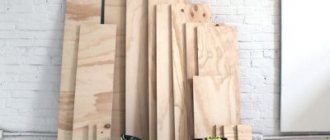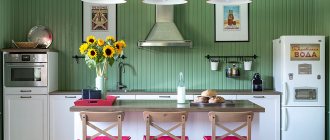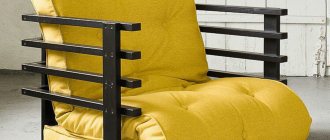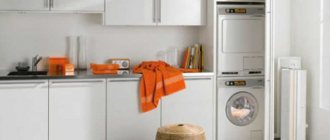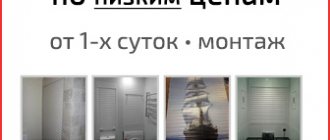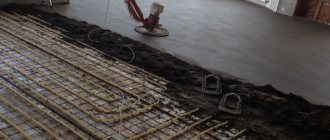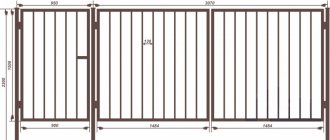49427
Arranging a comfortable living space, a comfortable office room, a sales area or a warehouse depends on the correct choice of furniture units. All types of furniture can be divided into cabinet, modular, project, upholstered products and structures made according to individual projects. Factory models are popular among consumers due to their affordability. However, in most cases, after purchasing ready-made cabinet units, furniture assembly is necessary, unless installation of the products by specialists is provided.
Basic Rules
First of all, in order to assemble any piece of furniture well, it must be of high quality. Therefore, when accepting delivery, first check the contents of your order. Most often, a single piece of furniture, or an entire set, should be accompanied by a list of parts, which will be the first part of your instructions for properly assembling the furniture.
Before this, you should have accurately measured the space that the furniture you bought will occupy, so that in the end it would not turn out that the conventional wardrobe simply does not fit in the right place.
Moreover, you need to take into account that the same cabinet must also be assembled indoors, and the latter must be spacious enough to comfortably carry out assembly and subsequent movements. Carpets should be removed and the floor itself should be covered with something like a blanket to protect the surface from damage.
Types of fasteners
Modern fasteners that are used when assembling furniture ensure the strength and durability of the structure, as well as its aesthetic appearance, since parts are fixed in a hidden way whenever possible, and those fasteners that remain outside are masked using special plastic linings to match the furniture .
Table 3. Types of fasteners
| Name of fastening element | Description |
Dowel | Dowels made of wood are used for preliminary fixation of two parts. After this, the structure is fastened with hardware. |
Furniture corner | Serves for fixing parts located at an angle of 90 degrees. This method is popular, but somewhat outdated and has its drawbacks - the element is not hidden, looks bulky and becomes loose over time. Corners come in plastic and metal. |
Confirmat | Modern furniture in most cases is assembled using confirmats - furniture screws, the threads of which, compared to conventional self-tapping screws, are larger, which ensures better fixation in the solid slab. After the screw is screwed in, the visible metal part is masked using a plastic plug to match the furniture. |
Eccentric coupler | Hidden fasteners used in the assembly of modern cabinet furniture from laminated chipboard. The holes for it are made in the factory using a Forstner drill. Considering that the thickness of the slab is 16 mm, and 12 mm must be selected for fasteners, the drilling accuracy must be ideal. |
Pinch bolt | Used to tighten two parts together. For example, bed bases and headboards. |
Beginner difficulty level
For simple pieces of furniture, you will need a simple tape measure, a hammer, a few screwdrivers (can be replaced with a screwdriver), a drill (situational), a hammer and a few wrenches. All this is enough to assemble the initial difficulty levels.
Read here: DIY cat house: drawings, diagrams and step-by-step instructions for creating houses
Complex designs
This category includes large pieces of furniture with a large number of parts, including moving ones, or furniture of complex shapes. Photos of assembling furniture with your own hands, of this type, can often be found in magazines and catalogs.
For it, in addition to the items mentioned above, you may need: a level, a hammer drill with various drills, a furniture stapler, and the like.
Required tools and fasteners
The benefit of self-assembling cabinet furniture is obvious: a person gets the opportunity to save on the wages of a furniture craftsman. Also, many will simply be interested in removing this process. We will describe in detail what tools may be needed in the process of assembling cabinet furniture on your own.
Current assembly and fixture tools:
- a 12, 14 or 18 volt screwdriver (with a bit for confirmation) is the main tool that will be required during the assembly and installation of cabinet furniture;
- PZ bits of different sizes for self-tapping screws: PZ1 for fixing Ø3 mm self-tapping screws, PZ2 in the case of using self-tapping screws with a diameter of 3.5-5 mm, PZ4 for mounting eccentric ties Ø15 mm;
- confirmation drill for organizing holes for hardware;
- awl;
- a simple pencil for marking furniture parts, a ruler;
- cutter for hinges.
It is also extremely important to understand what fasteners will be needed, especially for an inexperienced furniture maker. The most popular options are products of different sizes with cross-shaped slots. We will describe the most popular of them below.
| Size | Characteristic |
| 3.5x16 | They have a countersunk cross head and are most popular when installing cabinet furniture. |
| 4x16 | Used for fastening hinge counters for self-tapping screws. |
| 3x16 | They are optimal for installing guides on the sides of drawers and fixing the back wall made of fiberboard in the lining, as they have small caps. |
| 3.5x12 | Suitable for fixing hinge cups to MDF doors (especially those coated with varnish or paint). |
Dresser
Let's look at a diagram of assembling furniture with your own hands using the example of an ordinary chest of drawers. The item is very useful, and in any living room - it’s hard to imagine a bedroom or children’s room without it.
Previously, its role was played by simple chests. The disadvantage of this piece of furniture was its very simple design - at its core, it was a box that was closed with a lid, which is very inconvenient for storing a large amount of clothing, despite its obvious spaciousness.
Its modern analogue, a chest of drawers, is well suited not only for outerwear, but also for shoes, cosmetics and other things that the owner may need.
How to make built-in furniture: making a built-in wardrobe with your own hands
Many apartments still have old, Soviet-made furniture that has long gone out of fashion, physically and morally outdated, cluttering up the space of already very small rooms. However, at the same time, it should be noted that most often the material from which it is made has retained good quality, and it can be used to build modern versions of cabinets and bookshelves.
How to make built-in furniture
If you recall furniture walls with numerous cabinets, drawers and cabinets, you can easily imagine how many panels of different sizes can be obtained in order to make more compact, comfortable and modern pieces of furniture. How to make built-in furniture in a modern design, spending a minimum of money on it, and at the same time freeing rooms from bulky outdated structures will be discussed further.
Advantages of built-in furniture
Before moving on to the next sections, it is advisable to understand the advantages of built-in furniture made by yourself.
Built-in furniture elements help maintain the style of the interior while saving space
- If the furniture is made from material that will be obtained as a result of dismantling old cabinets or other pieces of furniture, then you can get significant savings on the family budget.
- Everyone knows that even in panel houses the walls are often not perfectly even. Well, with the help of built-in furniture you can perfectly disguise this flaw, and, again, save on construction work to level the surfaces.
- The owners are given an excellent opportunity to show their creativity when developing a project, and then reproduce their own design and engineering solution, making a piece of furniture that is as comfortable as possible for use.
- Serious savings in the usable space of the room are achieved. Almost every apartment has areas where it is difficult to fit standard pieces of furniture, and for those items that will be made to order, you will have to pay double the price. When developing your own project, you can provide for all the nuances and dimensions of the area where the cabinet or shelf will be built.
- And, of course, furniture made with your own hands will give you a reason to be justifiably proud of your amateur talents.
Materials for the manufacture of built-in furniture
In addition to chipboard panels, inherited from disassembled cabinets, other materials can be used to make pieces of furniture.
Original wardrobe made of plasterboard
- Today, plasterboard is extremely popular, from which not only built-in wardrobes are built, but even entire walls with niches and cabinets for one or even two rooms. This material has become so widespread due to the ease of its processing and the ease of installation, which can be carried out even by novice craftsmen with no experience. Its low price and environmental friendliness are also attractive.
Try to innovate your room with drywall!
You can learn how to work with this material correctly, quickly and easily creating various structures, from a special publication on our portal dedicated to the independent construction of plasterboard walls and partitions .
Natural wood is perhaps the best material for furniture, but you will have to pay a lot for high-grade material
- Natural wood has traditionally been an excellent material for making furniture. The old masters managed to build cabinets without a single nail, and some of these pieces of furniture, made at the beginning of the last century, are still in use today. Wood has many very important advantages over other materials - environmental friendliness, natural pattern and relief, ease of processing and aesthetic appearance.
Plywood is used for many built-in furniture elements
- Plywood is another material that can also be used to make built-in furniture. It is often used in combination with wood, covering frames with plywood and making panels. The manufacturing process of plywood involves the use of glue, so it cannot be called a 100% environmentally friendly material, although there are varieties with minimal, almost zero emission of phenol-containing substances.
The vast majority of furniture nowadays is made from chipboard or MDF.
- Chipboard is a board made from sawdust and shavings, which are mixed with glue and then pressed into a given shape. Then the slabs are given an aesthetic appearance by lamination or veneering. Such boards can be harmless to health or dangerous, depending on the glue that was used in their manufacture. Soviet furniture most often consists of slabs produced in accordance with GOST under strict control, so it can be called relatively safe compared to modern products of completely unknown origin. If furniture panels are purchased in a store, you should pay attention to the environmental safety group - E0 or E1 are required for living rooms.
Elements of furniture fittings are presented in specialized stores in a very wide variety
- In addition to materials for making furniture, it is necessary to select modern fittings that suit the design - handles, locks, canopies, guides, rollers, hangers, etc. There will be no problems with these furniture accessories, since today they can be found in specialized hardware stores for every request and taste.
Find out how to choose the right transformable bed for a small apartment from our new article.
Where can built-in furniture be installed?
Built-in furniture is an excellent way out of small-sized or one-room apartments. It can be fixed, as mentioned above, near walls that have never been used to install cabinets along them. In addition, it will fit perfectly into a wall that has a small surface area and is too small to install a standard cabinet. Such areas of rooms mainly include external walls, with window openings located in them, and internal ones, with a door frame located in the center.
It would seem a “useless” wall, but it can also be used rationally
They usually try to cover the wall around the window with curtains, without even thinking that it can be functional - this is what the vast majority of apartment owners do. However, if a set of shelves is fixed on its surface, having a shallow depth sufficient to accommodate books, then the structure does not fit the same curtains and cornices. They can easily be fixed not only to the ceiling, but also to the panels of the upper shelves. Having installed such a structure, you can immediately see how much area of the room will be freed from cabinets, and plan it for other needs.
closet
This wall of the room can only be used if it is absolutely dry, without the appearance of mold formations, otherwise the pathogenic microflora will quickly spread to the books, and its spores will hover in the air of the rooms, which is quite dangerous for human health.
Paper is an excellent insulator, and books placed on shelves close to each other will create a kind of heat-insulating barrier, so the room will become warmer.
Built-in wardrobes surround the front door
Another common option for installing built-in wardrobes is in the area of walls around interior or entrance doors. By securing the furniture in this way, you can solve two problems - saving space and additional soundproofing of the room.
Calculation of dimensions and drawing up drawings
Once you have chosen the location where the cabinet or shelving will be installed, you can begin to plan the placement of shelves and doors. The process of making a sketch and drawing with exact dimensions can be done using special applications - they can be found on the Internet. If this path seems difficult, then an ordinary sheet of paper, pencil, or ruler will do.
The key to successful installation of built-in furniture is a carefully thought-out drawing
The first calculation option will be more accurate, since the program will calculate not only all the parameters of the cabinet, but also the quantity and even the approximate cost of parts and fittings.
Video: example of designing a built-in wardrobe using a specialized application
The self-planning method helps you understand all the nuances right on the spot and makes it possible to immediately make the necessary adjustments. But you will have to work very carefully on the drawing, since all the necessary parts will be made from it. Particular care in drawing up the diagram will be required if the parts will be made according to it to order, in a workshop.
If a piece of built-in furniture will be constructed from chipboard, plywood or solid boards of approximately the same thickness, then the drawing for them is drawn up in the same way. If plasterboard is used to make a cabinet or shelves, calculations are made taking into account the width of the metal profiles from which the frame will be mounted, since the narrowest of them is 50 mm wide and 27 mm deep.
Find out how to make a wardrobe on the balcony with your own hands with illustrated instructions from a new article on our portal.
Built-in wardrobe with rear panel
Such a cabinet can be made of chipboard, plywood or solid boards 16 mm thick. Built-in furniture is equipped with a back panel covering the wall surface, or the interior wall itself serves as it.
This cabinet model has a height of 2600 mm, a width of 2400 mm and a depth of 650 mm. This design includes a back panel, but it is quite possible to simply mount the cabinet to the wall.
Parts for assembling the cabinet
Drawing of the internal structure of the cabinet
For such a cabinet you will need to make the following parts:
| the name of detail | Part size, mm | Number of parts, pcs. | ||
| Length | Width | Height | ||
| Side walls | 2584 | 650 | 2 | |
| Internal vertical partitions | 2568 | 550 | 2 | |
| Cabinet bottom panel | 2068 | 650 | 1 | |
| Cabinet ceiling panel with rounded corner | 2584 | 650 | 1 | |
| Vertical panel extending beyond the cabinet | 2600 | 308 | 1 | |
| Horizontal side shelves with rounded corner | 634 | 285 | 3 | |
| Drawers | 2568 | 586 | 220 | 3 |
| Lower horizontal shelves | 650 | 400 | 1 | |
| 800 | 400 | 1 | ||
| Upper horizontal shelves | 650 | 550 | 1 | |
| 800 | 550 | 1 | ||
| Horizontal shelves above drawers | 550 | 586 | 5 | |
| Back panels are made of plywood or fiberboard (5 mm thick) | 2600 | 665 | 1 | |
| 2600 | 816 | 1 | ||
| 2600 | 610 | 1 | ||
| Door panels | 2600 | 694 | 1 | |
| 2560 | 669 | 2 | ||
| Set of rollers | 2 sets | |||
| Drawer guides | 550 | 6 pairs | ||
| Shelf holders | 44 | |||
| Metal tubes with a diameter of 15 mm | 816 | 1 | ||
| 665 | 1 | |||
| Drawer details: | ||||
| Front and back walls | 586 | 220 | 6 | |
| Side walls | 518 | 220 | 6 | |
| Bottom panel (plywood or fiberboard) | 586 | 550 | 3 | |
| Sliding door guides with two lines of runners for movement | 2068 | 50 | Set (upper and lower) | |
Manufacturing of parts
Manufacturing parts for any furniture structure is a rather complex and labor-intensive process that requires not only high precision, certain dexterity and increased accuracy, but also the availability of special tools for working on workpieces.
| Illustration | Brief description of the operation performed |
| The first step is marking the chipboard panels, transferring the dimensions from the design drawing onto them and drawing cut lines. Next, all the cabinet parts are cut out. It should be noted that if the cutting is done with a hand hacksaw, it will require a lot of time and effort. Therefore, the work will go faster and more accurately if it is carried out using an electric circular saw or, in extreme cases, a jigsaw. To ensure a smooth edge without burrs, the cut must be made with a saw with fine teeth. In addition, it is recommended to stick masking tape along the edge of the cutting line, which will protect the laminated edge from chipping. If the edges are not quite even, they need to be trimmed with a file, rasp or plane. If you need to get a perfectly smooth edge of the parts or the model has rounded corners and other pattern configurations, then it is better to contact a workshop where there is special equipment that produces precise, down to the millimeter, cutting of any shape. | |
| If the furniture is made from panels obtained as a result of dismantling an old wall, and the height of the panels is not enough to build the intended project, then they will have to be increased. | |
| The connection of individual sheets can be done in different ways - this is a “groove-tenon”, using dowels, or using a special joining strip, into which two separate parts of the panel are installed on both sides with glue. The last connection method is the simplest, and is accessible even to an inexperienced craftsman. | |
| This cabinet model has shelves with rounded corners. To cut it beautifully, you need to draw a patterned cutting line using a construction or improvised compass. When sawing off rounded corners, use a jigsaw, being especially careful. | |
| The sawn parts are numbered and signed. If there is an appropriate tool, all edges of the parts are finished by milling. Then the finished parts are installed on the wall, following a certain sequence to simplify the search for the desired structural element. | |
| The outer end sides of the panels are covered with PVC edges specially designed for this purpose. The edges are secured to the end using a layer of glue applied to them, which begins to exhibit its adhesive properties after heating. To do this, the edge is placed on the end of the panel and smoothed with a heated iron. After the panels are processed and ready for assembly, the joints with other parts are marked on them, as well as the fastening of the fittings. |
After all the parts have been manufactured, processed and laid out, the cabinet is assembled in accordance with the drawing.
If the cabinet or rack has a back panel that will give the product additional rigidity, then after connecting all the structural elements to it from the back side, sheets of the back wall are attached to the ends of the panels, which are most often made of fiberboard or plywood with a thickness of 3÷5 mm . If the back wall is not planned, then the cabinet frame will have to be attached to the wall.
The presented cabinet can be assembled in different ways, and which one to choose is up to the master himself. Much in this case depends on the quality of the wall. To understand how the assembly is carried out, both installation options will be considered below.
Assembling a cabinet with a back panel
Built-in cabinet with a solid rear panel (wall)
The cabinet, secured with a rear panel, is assembled in the following sequence:
| Illustration | Brief description of the operation performed |
| The first step at the place where the cabinet will be located is to level its bottom part. Unfortunately, the floors are not always level, so if necessary, small wooden pads are installed at one or two corners. In this case, it is advisable to immediately secure the exposed bottom of the cabinet to the floor surface. | |
| You can, of course, attach adjustable legs in the corners and in the middle part of the bottom panel, but this is done if the differences in floor height are very significant. In addition, you need to take into account the height of the cabinet. If it is close to the height of the ceiling, then the legs will not be suitable for the structure, and you will have to use wooden pads. The front end side of the floor panel must be covered with PVC edge. | |
| Next, after marking, it is necessary to prepare holes on the vertical panels of the cabinet for installing shelf holders, if they are removable, or for furniture corners, if the shelves are permanently fixed. The latter installation method will make the structure more rigid. | |
| Another way to secure shelves to vertical cabinet panels is to use eccentric screws. This fastener is more accurate and almost hidden from view, but it is more difficult to drill holes for it, as it requires perfect accuracy. | |
| In addition, runners for drawers are attached along the drawn lines on the walls. | |
| If there are sockets or a switch mounted on the wall near which the cabinet will be installed, and it will cover them from the cabinet panels, then holes of the required size and shape are marked and drilled in it using a drill or jigsaw. | |
| The next step is installation along the lines of the vertical walls marked on the bottom panel. They will have to be temporarily supported on the sides, since they will not be supported only by the lower fastenings. To hold them in the desired vertical position, several horizontal transverse shelves should be secured without much delay. Since this design has side rounded shelves, to secure them it is necessary to connect the outermost vertical panel and the board adjacent to the wall at a right angle. The board is secured with its end side to the outer side wall using eccentric screws on the rear side of the structure. | |
| Having fastened two vertical panels at right angles, you need to immediately install the side shelves. They are mounted on the side vertical wall of the cabinet using dowels installed with glue, and on the wall panel using confirmats (Euroscrews) that are screwed into the back side of the panel. | |
| Then, the top panel-roof of the cabinet is installed and secured - it is most often mounted using eccentrics. If the top panel is raised right up to the ceiling, then through it you can fix the cabinet on the ceiling. | |
| Another way to secure the top panel, as well as horizontal shelves on vertical partitions, can be furniture corners. After installing the top panel, all other shelves and hanging rods are secured. | |
| Next, three drawers are made according to the dimensions indicated in the table. For more accurate joining of the corners of the box elements, quarters can be selected along their edges. Drawers can have one front panel or two - internal and front. When installing a double front panel, the drawer handle will be held more firmly. In the lower part of the side, front and rear walls, slot-like grooves are cut into which the bottom of the box will slide. | |
| Therefore, the assembly proceeds as follows: - first, the front and side panels of the drawer are fastened together; - then the bottom part is pushed into their grooves; - and only after that the back panel is installed with glue, which is additionally fixed with furniture screws. It should be noted here that you can use ready-made drawers from a disassembled furniture wall, replacing only the front panel with them. In this case, when drawing up a project, it is necessary to immediately take into account all their parameters. | |
| The second part of the roller guide system must be secured to the side walls of the drawers using self-tapping screws. | |
| The guides can be attached to the bottom or middle of the side panel. In order not to be mistaken in the correct installation, you need to try on the drawers in the cabinet walls, based on the dimensions given in the drawing. | |
| Next, handles are selected for the drawers. For them, through holes are drilled in the centers of the front panels, and then the handles are screwed from the inside of the drawer. | |
| The next step is to install guides for sliding doors. The presented model has three door leaves: - the middle one, installed on the first line of guides, and having the ability to move to any side of the cabinet; - two side doors, each of which, when opened, can reach the other along the second line of guides. | |
| Using the markings, the upper rail for moving the doors is attached to the ceiling panel of the cabinet, and then the lower rail is attached to the floor panel. Next, spring rollers are attached to the doors, allowing you to easily install the doors into the fixed guide rails. |
If desired or necessary, the structure can be fixed not only to the floor and ceiling, but also to the wall through the adjacent side panel of the cabinet from inside the structure.
The installation of compartment doors was mentioned in passing. But this is an extremely important point that requires comprehensive consideration. It is simply more expedient to refer the reader to detailed specialized instructions.
How to assemble and install wardrobe doors yourself?Special components are sold in stores for such furniture elements. Very detailed illustrated instructions for self-assembly and adjustment of wardrobe doors can be found in a special publication on our portal.
Built-in wardrobe mounted directly to the wall
This section of the article will look at ways to attach the same cabinet (or any other) to the wall, without using the back panel. As mentioned above, this option is perfect for hiding uneven walls in a room.
Parts for cabinets are manufactured and processed in the same way as in the previous version or when choosing a different model. Their list and dimensions also remain unchanged, with the exception of the rear panel.
You can add to the list of materials with metal corners, with the help of which the walls of the cabinet will be fixed to the wall, or with timber, which can replace the corners and act as a wall frame. It should be noted that if the cabinet shelves are open, then it is better to use metal corners or a profile for fastening - these elements look more aesthetically pleasing than timber.
To understand how such installation is carried out, you need to consider its options in more detail.
The first option is a prefabricated panel structure
This cabinet can be either open or closed with sliding doors. In this case, the shelves are installed using metal corners. Work on its installation occurs in the following order:
plywood
Cabinet without back wall, with wall mounting
- The first step is to draw up a design for a closet with the compartments that will be needed - these could be shelves for books, a wardrobe compartment or drawers intended for other needs. In the project, real dimensions are taken on a smaller scale - this is necessary in order not to make a mistake in the width or height of the location of certain parts. Moreover, it is better to make two copies of the project - on one of them put down the dimensions of the location of the parts on the wall, and on the other - the parameters of the structural elements themselves.
- Next, from a copy of the project, which shows how and where the vertical walls, as well as the top and bottom panels (if provided), will be primarily fixed, the places of their fixation are transferred to the wall. They must be determined by drawing precise vertical lines - along a plumb line.
- The first to be fixed to the floor is the floor panel of the cabinet, onto which vertical partitions can be fixed.
- Then, in the places of the drawn lines, the verticality of the wall plane is determined. To do this, you will need to prepare a perfectly even beam with a cross-sectional size of approximately 50×50 mm and a length almost equal to the height of the room’s ceiling, and a building level, or a level with a length of at least 2500 mm.
A level is placed on the wall at the indicated location, and with the help of it the difference in surface differences is determined. If it is about 3 mm, then this will not greatly affect the installation of the panels - even if a small gap is formed, then with the built-in version of the cabinet it will be almost invisible.
- In the case where the wall even visually looks uneven, there are two options to hide this flaw - level the wall with plaster or drywall, or fit the furniture panels of the side walls to the wall. The adjustment will have to be carried out gradually, cutting off the part from the panel that prevents it from completely pressing against the wall. Therefore, the side that will be adjacent to the wall will become uneven, but the front edge will be perfectly level.
- If the cabinet is mounted between two walls, then it is quite possible to completely abandon the outer vertical panels, installing only internal partitions.
- When the vertical panels are fitted to the wall, they should be immediately secured to their intended places so that you can begin marking the horizontal shelves, ceiling and floor front strips. To fix the vertical panels, metal corners are screwed onto them in three or four places on both sides. Then, the panel is leveled in relation to the walls, and on them, through holes in the corners, places are marked for drilling holes into which the dowel will be driven in and fasteners screwed in.
- Further, if you plan to install sliding doors on a built-in wardrobe, then bars or strips parallel to each other are marked and secured on the ceiling and floor or bottom panel, determining the width of the internal space and intended for securing guide rails for moving the doors.
Option for placing top, bottom and side false panels
- The next step, between the vertical internal partitions and walls, according to the drawing, is to mark the location of the horizontal shelves. Just like in the previous version of the cabinet, they are attached to furniture corners to vertical panels and walls. Horizontal shelves will connect the entire structure, secure it to the walls and give it rigidity.
Installation of the guide on the upper false panel
- Next, rods for hangers and runners for drawers, if provided, are installed; the drawers themselves are made according to the dimensions of the project and installed in place.
- The final stage is the assembly and installation of sliding doors.
The second option is with a timber frame
This design is most often used to build a built-in wardrobe, since it is the easiest to work with.
aluminum profile
Making a frame structure from timber for a built-in wardrobe
To build it, first a frame is mounted from a wooden beam according to markings on the wall, which immediately determines the dimensions of the cabinet, that is, its height, width and depth. When these values are known, it is easier to carry out the further process of securing the remaining elements of the cabinet and covering it with one of the selected materials.
A durable wooden frame can be covered not only with chipboard, but also with plywood, wooden or laminated fiberboard, as well as PVC panels - this criterion is chosen by the home craftsman himself, taking into account financial capabilities, design ideas and level of experience in working with a particular material.
It is much easier to attach both corners and panels to a wooden beam, so the work after erecting the frame will go quite quickly. The marking of horizontal shelves occurs in the same way as in the previous options, and vertical partitions are usually always formed by timber. Thanks to a more durable design, such cabinets can be equipped not only with sliding doors, but also with hinged ones - in some cases, the second option is preferable to the first.
The third option is with aluminum profiles
It is also quite possible to install a built-in wardrobe using this technology yourself, if you can produce all the necessary parts for the structure. An important condition when choosing the presented option for building a cabinet is that it can only be installed between two walls, that is, in a fairly narrow room, but across its entire width.
An original and fairly easy-to-assemble design using aluminum profiles
With this approach, to attach the panels to the wall, an aluminum U-shaped profile is used, which has a clearance width between the shelves that is 1÷2 mm greater than the thickness of the chipboard panels from which all other cabinet elements are made. In the presented model, the profile width is 16 mm, with a panel thickness of 15 mm.
U-shaped aluminum profiles fixed to the walls become a frame for installing parts made of chipboard or plywood.
The panels are neatly installed into the profile, and often do not require additional fastening at all. In those places where the shelves will bear a higher load, the bottom profile is additionally reinforced with a small chipboard panel.
Work on installing the cabinet occurs in the same sequence as when starting the assembly of any structure attached to the wall:
- Drawing up a project.
- Manufacturing of cabinet parts.
- Marking the wall surface using a plumb line, level, ruler and tape measure.
- Fastening to the wall according to the markings of the metal profile.
- Laying and fixing the floor panel and screwing profiles to it for installing vertical panels.
- Installation of vertical partitions - they are slid into a profile mounted on the wall and on the floor panel.
- Next, the top horizontal panel is tried on, and the location of the vertical partitions is marked on it. Then, it is removed, and profiles are also screwed to it, which will hold the partitions in their upper part. After this, the top panel is finally installed.
Installation of built-in wardrobe elements on aluminum guide profiles
- Then, all other horizontal shelves are mounted in the same way. They are installed in profiles that are fixed to the wall and to vertical panels. When the horizontal shelves are secured, the structure will become more rigid and durable.
- If the project includes the installation of drawers, then they must be installed between two chipboard panels, since without support on both sides they may not withstand the load. Therefore, this must be taken into account when designing.
The assembly is completed with the same installation of sliding sliding doors
- In the design example under consideration, sliding doors are planned, so for them, two-runner guides are fixed to the ceiling and bottom of the cabinet to move them, since both doors must move in one direction or the other.
- The last step is to install the movable door leaves and test them.
To conclude the publication, here is another clear example of high-quality assembly of a built-in wardrobe:
Video: assembly of a built-in wardrobe without a back wall
So, if you have the necessary tools, assembling built-in furniture with your own hands is a completely doable task. Much more difficult seems to be the high-quality production of all structural parts. It is best to carry out this process with professional tools, which are not found in every home. Therefore, having completed and thoroughly checked the drawing, having all the necessary materials, it is better to order their cutting and processing in a carpentry workshop - it will be much faster and more accurate. And with high-quality, well-fitted parts, the installation process becomes a real pleasure.
Blueprints
If we talk about step-by-step assembly of furniture with your own hands, then you should always start with drawings. First you need to decide on the place where the chest of drawers will stand - depending on this, it can be made higher or wider.
As for the assembly process itself, here the drawings, namely graphic and text descriptions, will help you assemble the furniture not only correctly, but also quickly - usually they serve as simple assembly instructions, which good stores supply with almost any piece of furniture.
For example, IKEA completes all its designs with all the necessary documentation, consumables in the form of screws, bolts, and the like.
If the kit contains fastenings that require a special tool (hexagon) - this is also included in the delivery kit.
Features of the material
Prices for laminated chipboard
Laminated chipboard
Laminated chipboard contains natural wood - in structure it is chipboards that have undergone high-quality sanding and covered with melamine film. It is this coating that distinguishes the two types of slabs. Laminated chipboard has high moisture resistance and greater strength than conventional boards.
The laminated surface exhibits greater resistance to mechanical influences, as well as to chemically active substances - acetone, gasoline, alcohol, acids, solvents, coffee. Therefore, furniture made from chipboard can often be found in public places: in reception areas, in offices, in multifunctional centers, in educational institutions, in cafes, in kindergartens, in playrooms and children's rooms, in the kitchen.
The advantage of the material is the variety of its shades and textures
The film not only gives the material excellent performance characteristics, but also allows you to give it a unique appearance - from any shades and textures of natural wood, to images applied according to individual sketches. The ability to choose any shade allows you to produce cabinet furniture for any interior. This is especially true for children's rooms, where bright, rich colors are welcome. Bright furniture is also used for advertising and trade stands, as a body for reception desks with the possibility of being manufactured in the company’s colors with a logo.
Multifunctional cabinet furniture
Note! The laminated layer makes the surface of the chipboard monolithic and does not allow harmful substances that may be contained inside its structure to pass through.
The formation of the laminated layer occurs by pressing paper, which acquires properties comparable to plastic, filled with melamine resin under pressure (up to 28 MPa) and high temperature (up to 210 degrees). Decorative paper impregnated with resin is pressed into the top layer of chipboard.
The surface of such a plate, among other things, is heat-resistant, which allows you to place hot dishes on it - this has made laminated chipboard a popular material for making kitchen countertops.
Cutting laminated chipboard
